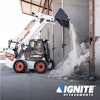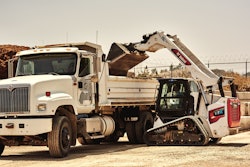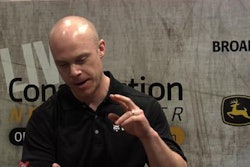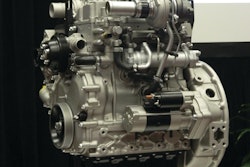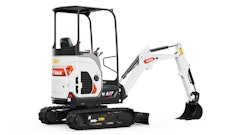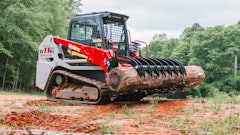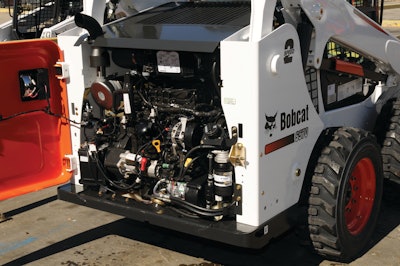
Over the past few months, Bobcat has begun rolling out its own brand of engines, which will not require the use of a diesel particulate filter (DPF). Recently, the company provided a closer look at its new engine technology and the other benefits it offers, including up to 12% more torque depending upon the application.
Bobcat initially rolled out a 2.4-liter engine in November. This will be followed by the launch of a 1.8-liter engine, and finally a 3.4-liter engine in 2015. Like other Tier 4 engines, they will utilize common technologies, including cooled exhaust gas recirculation, a high-pressure common rail fuel system and a diesel oxidation catalyst.
The 3.4-liter engine is expected to need selective catalytic reduction to be certified Tier 4 Final. This technology, requiring diesel exhaust fluid to help catalyze oxides of nitrogen out of the diesel exhaust stream, has been appearing on truck engines and larger off-road engines for some time. At present, it’s considered to be a necessary step to compliance for many engines.
Efficient Combustion Design
What makes the Bobcat engines unique is a specially designed combustion chamber that allows for ultra-low particulate matter combustion (ULPC). While this involves proprietary design and is more complicated to achieve than it sounds, it is really about fuel and air.
“The amounts of each that you use, the specific times that they are used and the pressure that they are injected into the combustion chamber — you manipulate all of those things in the exact right manner and the result is you get a much cleaner combustion process in terms of particulate matter,” says Chris Knipfer, Bobcat marketing manager.
Unlike a DPF that requires the operator to interact with the engine to keep it running properly, the technologies on the Bobcat engines are managed by the electronic control unit. Most of the time, the operators won’t even know they are there.
Bobcat worked with its parent company, Doosan, and some of the leading engineering consulting firms, including FEV and Ricardo, to develop an engine solution uniquely suited to the needs of its compact machines. Electronically controlled, high-pressure, common rail fuel injection is a core element of the engine technology.
By varying the fuel pressure, the engines can change the engine cylinder pressure to match conditions. This has allowed torque to be increased across the product line, with Bobcat branded engines above 25.5 hp increased from roughly 3% to 12% despite being slightly smaller in displacement than the engines they replace. “The way we get more torque is we have higher amounts of combustion pressure,” says Knipfer. “Our engines are designed to be more robust to be able to more adequately handle more pressure and torque.”
Combustion Pressure Matched to the Task
Combustion pressure will vary by the load. “For high-performance, torque-demanding jobs, more pressure is necessary,” says Knipfer. This includes digging, pushing and running a high-demand hydraulic attachment.
But not every job requires maximum torque — for instance, with light-duty attachments such as angle brooms or applications such as driving across a jobsite. The Bobcat engines can automatically monitor and vary the combustion pressure to produce the proper amount of torque for the job.
“Less torque for these jobs is required. The engine catches it and reduces the engine combustion pressure,” Knipfer explains. “The result is less engine noise and better fuel efficiency at that moment.” But this is highly dependent on application. “If you have somebody who pushes the machine to its limits most of the time, they are probably not going to see a reduction in noise or improvement in fuel efficiency vs. somebody who performs more light-duty operations.”
Since the Bobcat machines handle a wide variety of tasks, a wide torque band in advantageous. “Engines are designed for the size of the peak operating range they have,” notes Knipfer. Compact equipment can be digging one minute, lifting the next and then pushing. “So with compact equipment, our loads are constantly varying by a great amount.” A wider peak operating range is needed.
For this reason, the Bobcat engines were designed with a broad torque curve. In the graph above, you will note a 600-rpm wide torque range, with only a 6.5% difference in torque. In compact equipment applications, this wide torque range is an advantage since it allows operators to keep the machine in the desired torque range with the variable loads. With a more narrow range, you lose a significant amount of performance in the machine. The wider range allows both novice and expert operators to consistently fit in the preferred region of the torque band.
To validate this point, Bobcat turned to its customer base. “We blind tested customers on machines with the new engines and machines with the previous generation engines,” says Knipfer, “They preferred the performance of the machines with the Bobcat engine.”
Another benefit that will not be immediately obvious to customers is consistent power throughout the life of the engine. Most diesel engines provide negligible power loss through most of their life. “But there is a certain point you start noticing that it doesn’t have the power that it used to,” says Knipfer. “That happens with engines because they wear and become a little less efficient. They just do not have as much power or torque as they did when they were brand new.”
Just like any engine, the Bobcat engines are subject to the same type of wear; however, they will not lose the power or torque. “The Bobcat engine can manipulate the combustion pressure as the engine ages. At the point where the engine starts getting a little bit less efficient, the Bobcat machine will compensate and increase the combustion pressure a little bit to keep the power consistent,” says Knipfer.


